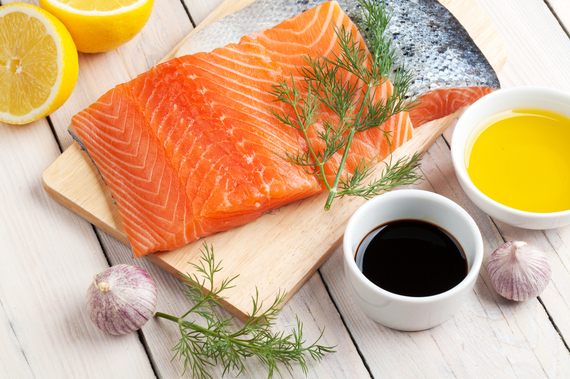By John Swartzberg, MD
Americans have had a confused, convoluted, love-hate relationship with dietary fats for a long time. Remember back in the 1980s, when low-fat diets reigned supreme only because fats have nine calories per gram, compared to 4 calories in protein and carbs?
The low-fat craze has ebbed somewhat in recent years as other nutrients -- primarily carbohydrates and, in particular, sugars -- have become the new villains of the diet scene. But many foods, ranging from yogurts and cottage cheese to peanut butter, salad dressing, and even hot dogs, are still marketed with the claim that they are "fat free" or "low fat." What does that really mean, and does it matter? What do we know about dietary fats today that we didn't know ten years ago?
Find out What's Making Us Fat?
First of all, no broad food category should be demonized -- including fats. Diets and food plans that call for you to eliminate any type of food are usually counterproductive at best and harmful at worst. It's hard to stick to a draconian regimen. Our bodies need to take in certain levels of carbohydrates and fats to function properly. Stay off the selective diet bandwagon, whatever song it's playing.
That said, there are some types of fats that are definitely better for you than others. Monounsaturated and polyunsaturated fats should be the mainstay of your fat consumption. Monounsaturated fats are the predominant fat found in many plant-based liquid oils, such as sesame oil, olive oil, peanut oil, and canola oil. Polyunsaturated fats are the predominant fat found in other oils like corn and sunflower oil, as well as in fatty fish like salmon, mackerel, and trout. They both can reduce levels of LDL cholesterol (the "bad" kind) and put vitamin E in your diet. Polyunsaturated fats also include essential fatty acids such as omega-3 and omega-6, which the body can't produce on its own.
On the other hand, saturated fats -- like those found in fatty meats, butter, cheese, and many baked goods and fried foods -- should be consumed only in moderation.
Some recent papers have suggested that reducing saturated fats in the diet does not necessarily reduce your risk of heart disease, but I think that's misleading. The research doesn't say anything about what people are eating instead of those saturated fats. Those cookies and cakes with a big "low fat" on their label are often high in sugars, refined carbohydrates, and calories -- potentially contributing to obesity, which itself is a risk factor for heart disease So if you cut back on the burgers and butter, but replace them with high-sugar, high-calorie alternatives, you're not going to see much benefit.
If you replace the saturated fats with polyunsaturated fats instead, the picture looks very different. One recent study found that if you swap 5 percent of the saturated-fat calories you get from red meat, cream and butter for calories from vegetable oils, nuts and seeds, you cut your risk of death from heart disease by 13 percent.
The Dietary Guidelines for Americans recommend keeping saturated fats to less than 10 percent of the calories you consume each day, which seems reasonable to me.
The one type of fat you should avoid completely if possible is trans fat. Manufactured trans fats, also known as partially hydrogenated oils, are found in many stick margarines, crackers, cookies, cakes, pies, and frozen foods. Evidence has been piling up that they do you no good and an awful lot of bad. One 2015 study found that people who ate higher amounts of trans fats were 34 percent more likely to die from any cause, and 28 percent more likely to die from heart disease, than those who ate lower amounts. Another study found that excess consumption of trans fats increased the risk of death from stroke, diabetes, and cancer.
In a few years, you won't have to worry about keeping trans fats out of your diet -- the FDA will do it for you. In 2015, the agency removed partially hydrogenated oils from its list of ingredients that are "generally recognized as safe" (GRAS). But manufacturers have a three-year window to comply, which means trans fats could still be on your grocer's shelves until 2018. So keep an eye on the ingredient list, and if "partially hydrogenated oils" (indicating trans fat) is anywhere on it, don't put it in your cart.
Something we all too often miss in the frenzy over the individual components of foods -- carbohydrates, proteins, and fats -- is the whole food. If you're staring at one line on the nutrition label, you're missing the full story. Read the entire label. Is that "fat free" food made with mountains of sugar? Does it contribute much -- or at all -- to your daily needs for nutrients like calcium, vitamin C, protein, or iron?
Put the individual whole foods you eat in the context of your overall diet. Ideally, about half of the food on your plate should be made from fruits and vegetables. A quarter should come from grains (preferably whole grain), and a quarter from protein such as meat. Focus your "food attention" toward that goal -- not on whether that ounce of cheese you eat with an apple is too high in saturated fat.
- How to Cut the Fat in Desserts
- How to Replace Bad Fats with Good
- Let's connect on Facebook!
John Swartzberg, M.D., is chair of the editorial board of BerkeleyWellness.com and the UC Berkeley Wellness Letter.
Follow Berkeley Wellness on Twitter.


